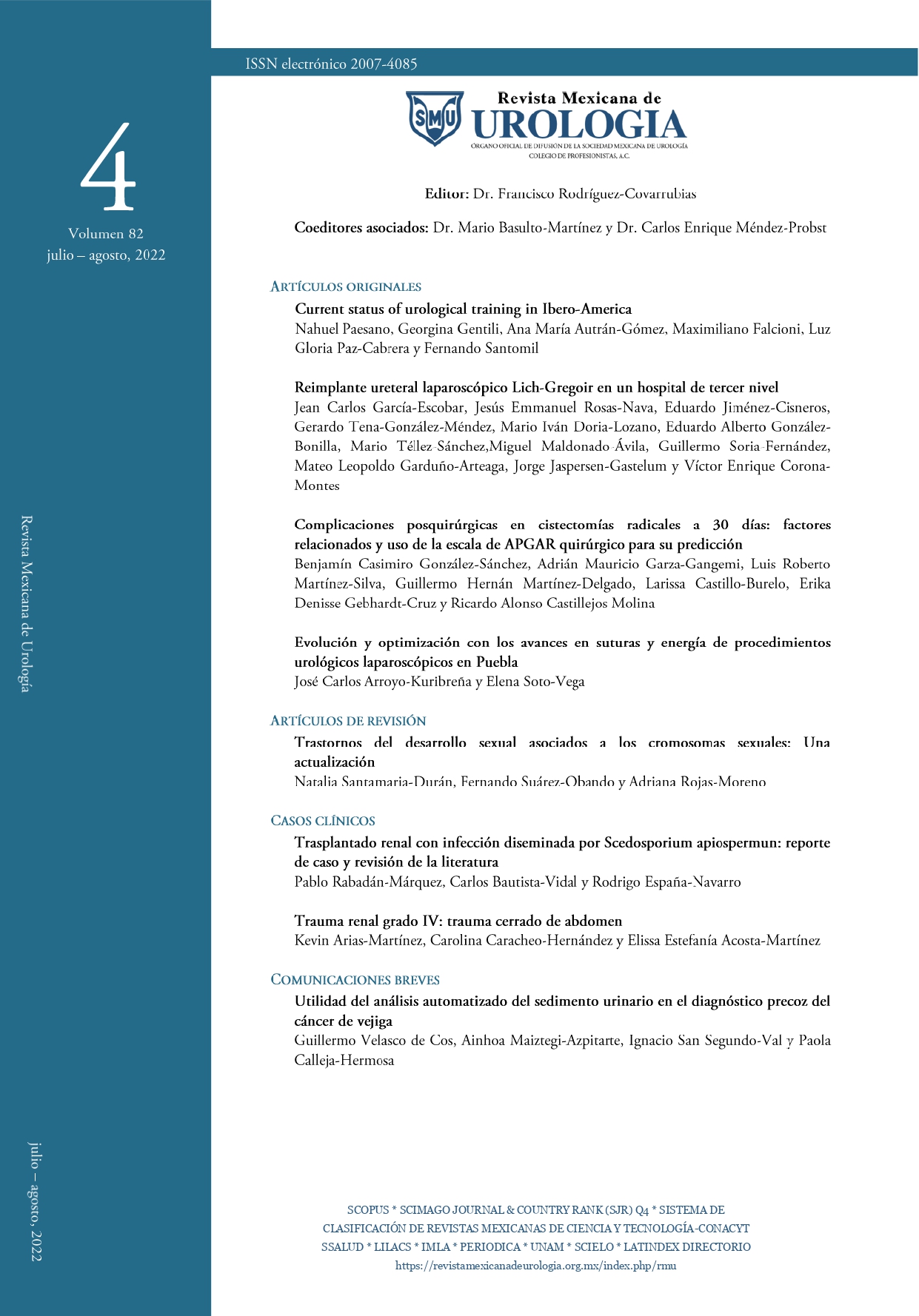Kidney trauma grade IV: abdomen closed trauma
DOI:
https://doi.org/10.48193/revistamexicanadeurologa.v82i4.812Keywords:
Kidney injury , Nephrectomy , blunt abdominal trauma , hematuriaAbstract
Description of the clinical case: A 16-year-old patient presented trauma with 48-hour evolution, after a fall from a moving bicycle, impacting on his left side against the pavement. The abdominal tomography revealed the presence of an expanding perirenal hematoma. An exploratory laparotomy was performed, observing hemoperitoneum and left renal hematoma, renal ileus injury with active bleeding, and expanding hematoma. It was decided to perform left nephrectomy.
Relevance: Kidney trauma is the most common genitourinary injury. About 90% are blunt trauma.
Clinical implications: Although most kidney traumas are limited and a rare cause of death, when they are not properly diagnosed and treated, they cause high morbidity due to late complications: arterial hypertension, hydronephrosis, traumatic pseudonephrosis, renal atrophy and renal lithiasis.
Conclusion: Young patients are in greater risk of abdominal injuries.
References
Camué-Moya RA, Sánchez-Barrero N, Bestard-Hartman I, Guerra-Cepena U, Blanco MP. Caracterización de pacientes con traumatismo renal. Revista Cubana de Medicina Militar. 2018 Mar 16;47(3):244–50.
Franco-Buenaventura D, Uribe-Bayona AJ, García-Perdomo HA. Manejo conservador en trauma renal contuso. Algunas recomendaciones para recordar. Revista Mexicana de Urología. 2020 Oct 28;80(5):1–11. doi: https://doi.org/10.48193/revistamexicanadeurologa.v80i5.560
Erlich T, Kitrey ND. Renal trauma: the current best practice. Therapeutic Advances in Urology. 2018 Oct 1;10(10):295–303. doi: https://doi.org/10.1177%2F1756287218785828
Bryant WK, Shewakramani S, Zaurova M. Emergency management of renal and genitourinary trauma: best practices update [digest]. Emerg Med Pract. 2017 Aug 22;19(8 Suppl Points&Pearls):S1–2.
Kozar RA, Crandall M, Shanmuganathan K, Zarzaur BL, Coburn M, Cribari C, et al. Organ injury scaling 2018 update: Spleen, liver, and kidney. J Trauma Acute Care Surg. 2018 Dec;85(6):1119–22. doi: https://doi.org/10.1097/ta.0000000000002058
Coccolini F, Moore EE, Kluger Y, Biffl W, Leppaniemi A, Matsumura Y, et al. Kidney and uro-trauma: WSES-AAST guidelines. World J Emerg Surg. 2019;14:54. doi: https://doi.org/10.1186/s13017-019-0274-x
Alsaywid BS, Alkhashan MY, Alrimawi MH, Abu-Alsaud NM, Al-Rimawi HM. Blunt renal trauma in pediatric population. Urol Ann. 2019;11(3):241–6. doi: https://doi.org/10.4103%2FUA.UA_149_18
Pillay V, Pillay M, Hardcastle TC. Renal trauma in a Trauma Intensive Care Unit population. South African Journal of Surgery. 2019 Dec;57(4):29–33. doi: http://dx.doi.org/10.17159/2078-5151/2019/v57n4a2764
García-Perdomo HA, Gómez-Puerto DA, Zapata-Copete JA, Manzano-Núñez R. Profilaxis antibiótica en el manejo conservador de los pacientes con trauma renal: ¿Aún existe controversia? Revista Urología Colombiana / Colombian Urology Journal. 2019 Sep;28(3):221–5. doi: https://doi.org/10.1055/s-0038-1651510
Okur MH, Arslan S, Aydogdu B, Arslan MS, Goya C, Zeytun H, et al. Management of high-grade renal injury in children. Eur J Trauma Emerg Surg. 2017 Feb;43(1):99–104. doi: https://doi.org/10.1007/s00068-016-0636-y






